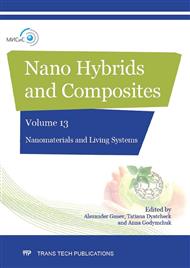[1]
M.S. Mansour, M.E. Ossman, H.A. Farag, Removal of Cd (II) ion from waste water by adsorption on polyaniline coated on sawdust, Desalination 272 (2011) 301-305.
DOI: 10.1016/j.desal.2011.01.037
Google Scholar
[2]
Y. Liu, L. Chen, P. Wang, Y. Dong, Synthesis of magnetic polyaniline / graphene oxide composites and their application in the efficient removal of Cu (II) from aqueous solutions, J. Environ. Chem. Eng. 4 (2016) 825-834.
DOI: 10.1016/j.jece.2015.12.023
Google Scholar
[3]
H. Yin, C. Wang, Q. Yan, Adsorption of Hg (II) from aqueous solutions by two aniline copolymers, Asian J. Chem. 24 (2012) 4901-4906.
Google Scholar
[4]
D. Shao, C. Chen, Х. Wang, Application of polyaniline and multiwalled carbon nanotube magnetic composites for removal of Pb (II), Chem. Eng. J. 185-186 (2012) 144-150.
DOI: 10.1016/j.cej.2012.01.063
Google Scholar
[5]
A. Olad, E.F. Azhar, Eco friendly biopolymer/clay/conducting polymer composite: Characterization its application in reactive dye removal, Fib. Polym. 15 (2014) 1321-1329.
DOI: 10.1007/s12221-014-1321-6
Google Scholar
[6]
S. Debnath, N. Ballow, A. Maity, K. Pillay, Development of a polyaniline – lignocellulose composite for optimal adsorption of congo red, Int. J. Biolog. Macromol. 75 (2015) 199-209.
DOI: 10.1016/j.ijbiomac.2015.01.011
Google Scholar
[7]
E. Gengec, Color removal from anaerobic/aerobic treatment effluent of backery yeast wastewater by polyaniline/beidellite composite materials, J. Environ. Chem. Eng. 3 (2015) 2484-2491.
DOI: 10.1016/j.jece.2015.09.009
Google Scholar
[8]
L. Yang, S. Wu, J.P. Chen, Modification of activated carbon by polyaniline for enhanced adsorption of aqueous arsenate, Ind. Eng. Chem. Res. 46 (2007) 2133-2140.
DOI: 10.1021/ie0611352
Google Scholar
[9]
J. Wang, X. Han, Y. Ji, H. Ma, Adsorption of Cr (VI) from aqueous solutions onto short-chain polyaniline/palygoskite composites, Desalin. Water Treat. 56 (2015) 356-365.
DOI: 10.1080/19443994.2014.935805
Google Scholar
[10]
Y. Lin, D. Li, J. Hu, G. Xiao, J. Wang, W. Li, X. Fu, Highly efficient photocatalytic, degradation of organic pollutants by PANI-modified TiO2 composite, J. Phys. Chem. C 116 (2012) 5764-5772.
DOI: 10.1021/jp211222w
Google Scholar
[11]
G. Sharma, D. Pathania, M. Maushad, N.C. Kothiyal, Fabrication, characterization and antimicrobial activity of polyaniline Th (IV) tundsmolybdphosphatenanocomposite material: Efficient removal of toxic metals ions from water, Chem. Eng. J. 251 (2014).
DOI: 10.1016/j.cej.2014.04.074
Google Scholar
[12]
I. Yu. Sapurina, M.V. Ivanova, V.T. Ivanova, E.I. Burtsena, S.V. Trushakova, E.I. Isaeva, E.S. Kirilova, Ya.E. Kurochkina, A.A. Manykin, L.V. Uryvaev, Polyaniline and its composites as sorbents of influenza viruses, Polym. Sci. A 56 (2014).
DOI: 10.1134/s0965545x14040129
Google Scholar
[13]
V.F. Ivanov, E.O. Garina, I. Yu. Sapurina, O.L. Gribkova, E.I. Burtseva, T.V. Ivanova, A.V. Vannikov, Sorption of flu viruses from aqueous media by composites of electrically conducting polymers: polyaniline and polypyrrol, Prot. Met. Phys. Chem. Surf. 52 (2016).
DOI: 10.1134/s2070205116020118
Google Scholar
[14]
B. Qiu, C. Xu, D. Sun, Q. Wang, H. Gu, X. Zhang, B.L. Weeks, J. Hopper, T.C. Ho, Z. Guo, S. Wei, Polyaniline coating with various substrates for hexavalent chromium removal, Appl. Surf. Sci. 334 (2015) 7-14.
DOI: 10.1016/j.apsusc.2014.07.039
Google Scholar
[15]
A.V. Melezhyk, A.V. Rukhov, E.N. Tugolukov, A.G. Tkachev, Some aspects of carbon nanotubes technology, Nanosyst. Chem Phys. Math. 20 (2013) 247-259.
Google Scholar
[16]
A. Melezhyk, E. Galunin, N. Memetov, Obtaining graphene nanoplatelets from various graphite intercalation compounds, IOP C. Ser. Mater. Sci. Eng. 98 (2015) 012041 (1-9).
DOI: 10.1088/1757-899x/98/1/012041
Google Scholar
[17]
T.P. Dyachkova, E.P. Redkzubova, Z.G. Leus, A.G. Tkachev, S.V. Blinov, A.V. Shuklinov, V.N. Druzhinina, The effect of modification with functionalized carbon nanotubes on polysulfone properties, Fundamentalnye issledovaniya [Fundamental Research] 8 (2013).
Google Scholar
[18]
H.P. Boehm, Some aspects of the surface chemistry of carbon blacks and other carbons, Carbon 32 (1994) 759-769.
DOI: 10.1016/0008-6223(94)90031-0
Google Scholar
[19]
T. -M. Wu, Y. -W. Lin, Doped polyaniline / multi-walled carbon nanotube composites: Preparation, characterization and properties, Polymers 47 (2006) 3576-3582.
DOI: 10.1016/j.polymer.2006.03.060
Google Scholar
[20]
D.A. Zilli, P.R. Bonelli, A.L. Cukierman, Effect of alignment on adsorption characteristics of self-oriented multi-walled carbon nanotube arrays, Nanotechnology 17 (2006), 5136–5141.
DOI: 10.1088/0957-4484/17/20/016
Google Scholar
[21]
I.V. Anosova, T.P. Dyachkova, A.V. Rukhov, Studying the regularities of carboxilated multi-walled carbon nanotubes modification with polyaniline, Fundamental'nye i prikladnye problem techniki i technologii [Fundamental and Applied Problems of Engineering and Technology], 313 (2015).
Google Scholar
[22]
T. Kar, S. Scheiner, A.K. Roy, The effect on acidity of size and shape of carboxylated single-wall carbon nanotubes. A DFT-SLDB study, Chem. Phys. Lett., 460 (2008), 225-229.
DOI: 10.1016/j.cplett.2008.06.007
Google Scholar


